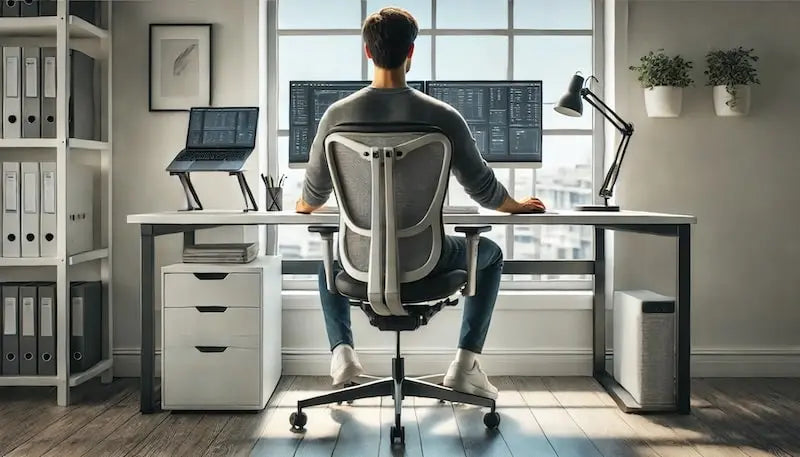An ergonomic work environment is the key to greater comfort and fewer health problems.
Poor posture or poorly placed work equipment can lead to back, neck and eye problems in the long term .
Small adjustments can make a big difference:
A monitor at the right height protects your neck, regular breaks prevent overexertion and the right lighting protects your eyes.
With the right sitting position and ergonomic aids (e.g. our HANDSAL or our NOTEUP ) you can make your everyday work more efficient and healthier.
Use the following short checklist to check whether your workspace is optimally set up. Create a healthy setup and increase your productivity at the same time!
Start today and adapt your workplace step by step!
Small changes lead to big improvements in well-being and productivity.
You can find the long print version of the checklist below in the download!
1. Sitting posture
Do you sit with a straight back?
Is the chair adjusted to the correct height so that your feet rest flat on the floor?
Are your knees at a 90-120 degree angle?
Are your thighs horizontal or slightly inclined?
Does the chair adequately support your lower back?
2. Table and work surface
Is the height of the desk adjusted so that your elbows form a 90-100 degree angle?
Are all frequently used items within easy reach without having to overstretch yourself?
Is the desk large enough to organize your workspace and rest your forearms?
3. Monitor
Is the monitor positioned so that the top edge of the screen is at eye level?
Is the monitor at least an arm's length away (approx. 50-70 cm)?
Do you avoid reflections or glare on the screen?
Do you use a central main screen when working on multiple screens?
Is the monitor positioned directly in front of you?
4. Keyboard and mouse
Is the keyboard at a height where your wrists are straight?
Do you use a wrist rest to support your wrists?
Is the mouse within reach and at the same height as the keyboard?
Do you use keyboard shortcuts to reduce mouse usage?
Do you have an ergonomic mouse that relieves strain on your wrists?
5. Lighting
Do you avoid direct light sources that cause glare or reflections on the monitor?
Is your work area well lit without being too dark or too bright?
Do you use an adjustable desk lamp to direct light when needed?
6. Breaks and exercise
Do you take a short break to stretch or stand up at least every 30-60 minutes?
Do you regularly change your position between sitting and standing to avoid strain?
Do you regularly perform eye exercises to avoid fatigue (e.g. “20-20-20 rule”: look 20 meters away for 20 seconds every 20 minutes)?
7. Additional considerations
Do you use headsets or hands-free devices to avoid clamping the phone between your shoulder and ear?
Is there enough freedom of movement at your workplace?
Do you regularly tidy up your workspace to prevent accidents caused by tripping or falling?
Download the complete checklist as a PDF:
Did you know that around 90% of office workers spend more than six hours a day on a computer? In the long run, this screen time can lead to health problems if the workstation isn't ergonomically designed. With proper sitting posture, monitor height, and regular breaks, you can prevent problems like neck and back pain.


Leave a comment
This site is protected by hCaptcha and the hCaptcha Privacy Policy and Terms of Service apply.